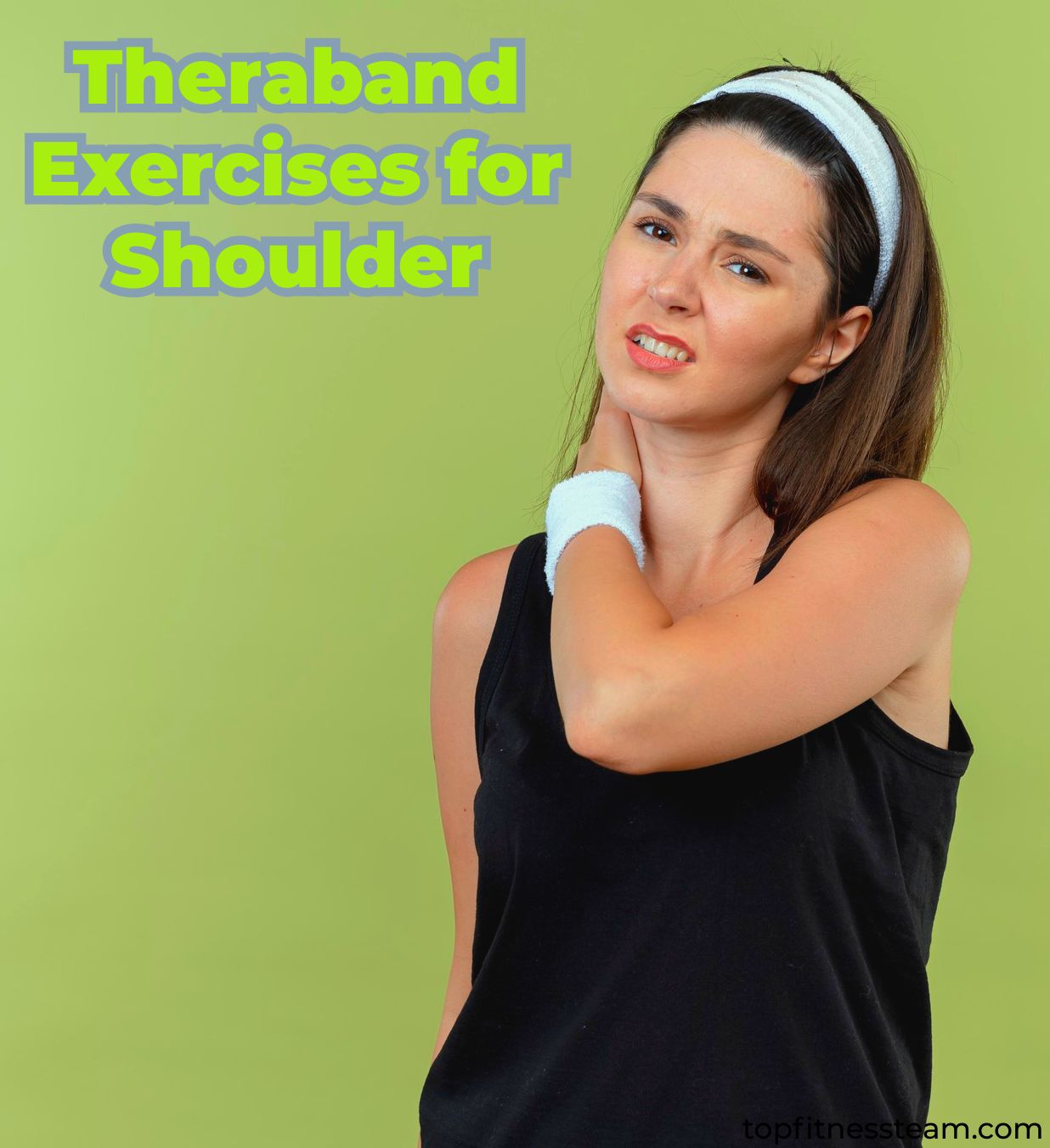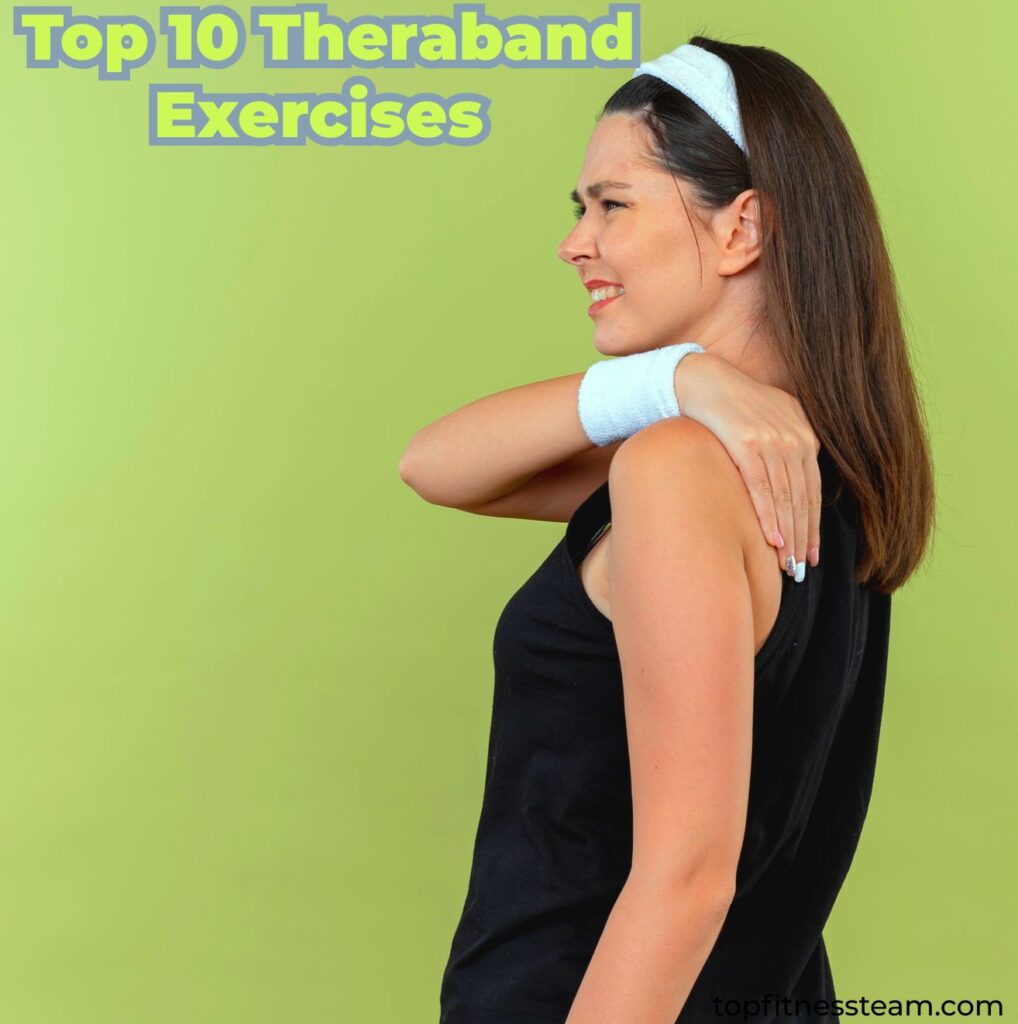Hello everyone, Top Fitness Team is here. I will tell you about the Top 10 Theraband Exercises for Shoulder Pain in this article.
Introduction
Shoulder strength and mobility are not just a luxury but essential for our daily tasks and muscular prowess.
Therabands, also known as resistance bands, offer a mobile and effective means to build and restore this vital area.
These bands, determined by their elasticity and color-coded resistance levels, are revolutionizing how we come to repair and strength training.
Want a deeper dive into the efficacy of band workouts? Check out the Top 10 Best Band Shoulder Exercises.
Top 10 Theraband Exercises For Shoulder Pain
1 Shoulder Flexion
- Stand with feet shoulder-width apart.
- Hold the Theraband with both hands in front of you, palms facing up.
- Slowly raise your arms in front of you to shoulder height, stretching the band.
- The Lower slowly and repeat.
2 Shoulder Extension
- Stand with feet shoulder-width apart.
- Hold the band behind you with both hands, palms facing back.
- Extend arms backward, stretching the band.
- Return to the starting position and repeat.
3 Lateral Raise
- Stand on the center of the band with one foot.
- Hold both ends with your hands by your sides.
- Lift arms and release the flanks up to shoulder altitude.
- Lower and repeat.
4 Shoulder External Rotation
- Hold the band with both hands in front of you, elbows bent at 90 degrees.
- Rotate hands outward, pulling the band apart.
- Slowly return to the starting position.
5 Shoulder Internal Rotation
- Anchor one end of the band to a door handle or similar fixed object.
- Hold the other end with your hand, elbow bent at 90 degrees.
- Rotate your hand toward your abdomen, stretching the band.
- Slowly release and repeat.
6 Scapular Retraction
- Hold the band with both hands extended in front of you.
- Pull hands apart, squeezing shoulder blades together.
- Slowly return to the starting position.
7 Front Raise
- Stand in the center of the band.
- Hold both ends with your hands by your sides.
- Raise your arms in front of you up to shoulder height.
- Lower and repeat.
8 Horizontal Abduction
- Hold the band with both hands in front of your chest.
- Rack the band separated by growing your arms to the sides.
- Return to the starting position and repeat.
9 Diagonal Pull (D1 & D2 patterns)
- Stand with feet shoulder-width apart.
- Hold one end of the band overhead and the other by your opposite hip.
- Pull the band diagonally across your body.
- Slowly remove and recite on the further side.
10 Shoulder Press
- Stand in the center of the band.
- Hold both ends with your hands by your shoulders.
- Press hands upward, extending arms.
- Lower slowly and repeat.
Note: Always consult with a physiotherapist or healthcare professional before starting any exercise regimen, especially if you’re dealing with pain or injuries.
The Importance of Theraband In Rehabilitation
Therabands have carved a significant niche in the kingdom of physiotherapy. Their dynamic resistance helps improve muscle strength, balance, and function post-injury.
Besides repair, they also cater to those looking to challenge their body in individual ways beyond traditional weights, such as dumbbells, which you can learn about in this shoulder workout guide.
Advantages Of Using Therabands For Shoulder Exercises
With a strategy primed for portability, Therabands are an excellent tool for on-the-go workouts.
Their variable resistance levels cater to beginners and seasoned athletes alike.
Also, unlike resistance training tools, Therabands promote muscle compacting, concentric (shortening), and strange (extension), improving overall muscle function.
Key Precautions
Essaying on a new exercise routine with proper guidance can be intense.
Selecting a resistance level that matches one’s capacity to prevent unnecessary strain is essential.
Good form is vital to provide the exercise benefits instead of harm.
Theraband Exercises For The Shoulder
From Shoulder Flexion to Front Raise, these exercises are tailored to target the involved musculature of the shoulder.
Each movement is created to ready specific muscles, enhancing shoulder health and function.
The complete guides supply you with full benefits from your workout.
Tips For Effective Workouts
Prioritizing a proper warm-up conditions the body for the intensity ahead. Maintaining a correct posture ensures the targeted muscles bear the brunt of the effort, reducing injury risk.
As strength and constancy grow, consider progressing in opposition, but always listen to your body.
Pros & Cons
| Pros | Cons |
|---|---|
| Portable and suitable for on-the-go workouts | It might require initial guidance to ensure proper form |
| Offers varied resistance levels for all fitness levels | Potential for overstretching if not used correctly |
| Cost-effective compared to other equipment | Durability concerns over time |
| Suitable for both rehabilitation and strength training | It might not provide enough resistance for advanced users |
Summary
Theraband exercises are undeniably transformative for shoulder health. But remember, always pair spirit with caution and consult with experts.
My Final Thoughts
Theraband exercises for the shoulder offer a universal and movable solution for strength training and pave the way for improved mobility, strength, and hurt precluding.
Welcoming these opposition exercises can enable individuals to take bold steps toward optimal shoulder health, regardless of where they are.
FAQs
Q: Do resistance bands work for shoulders?
Ans: Resistance bands are influential for strengthening shoulder muscles and improving mobility.
Q: Three exercises for the shoulder?
Ans: Consider the Shoulder Press, Lateral Raise, and Front Raise for targeted shoulder workouts.
Q: Fix shoulder pain with resistance bands?
Ans: Begin with guidance from an experienced and use low resistance, focusing on exercises beneficial for shoulder pain.
Q: What is the best exercise for weak shoulders?
Ans: The External Shoulder Rotation is excellent for managing shoulder weakness, targeting the rotator cuff.
Q: What causes the weak shoulder?
Ans: Common causes include rotator cuff injuries, lack of activity, aging, poor posture, and medical conditions like arthritis.
Thanks.

